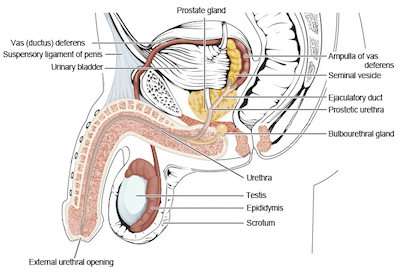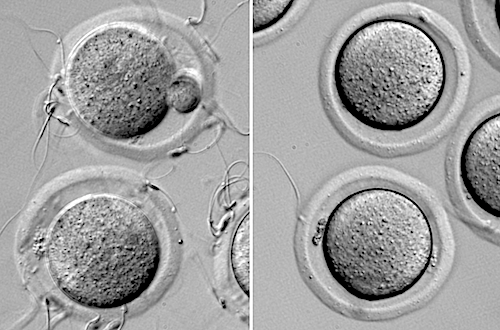|
|
Developmental Biology - Sperm
New Protein 'Turns On' Sperm
A newly identified protein chain of events leads to mature sperm...
Researchers from Osaka University and Baylor College of Medicine identify a protein secreted by the testis that travels downstream through the lumen to a receptor in the epididymis and leads to mature sperm.
Osaka, Japan and Houston, Texas, USA - For a sperm produced in the testis of a man to fertilize a woman's egg, the sperm must first mature in a man's epididymis. Now, an international team of researchers has identified a chain of events in which a protein secreted by the testis travels in the luminal fluid, binds to a receptor on the epididymis to induce its differentiation and secretion of a second protein that matures the sperm and enables each sperm to be motile in females.

In a new study is published in Science, researchers from Osaka University and Baylor College of Medicine have identified NELL2, a secreted protein factor that acts on the epididymis through this novel "lumicrine" pathway to mediate sperm maturation. Sperm are produced in the seminiferous tubules of the testis and transit through the epididymis, a long, convoluted tube linked to the vas deferens.
When sperm enter the epididymis, they are not motile and incapable of fertilization. However, in their passage through the epididymis, sperm are provided an appropriate environment in which to mature and be stored pending ejaculation.
It has been hypothesized that proteins released by the testis (upstream) could act on the epididymis (downstream). However, until now, proteins working through this intriguing lumicrine signaling system have remained elusive.
While it is known that the orphan receptor tyrosine kinase ROS1 expressed in the first segment of the epididymis is needed for sperm differentiation, neither factors regulating the initial differentiation of testicular segmentation nor the process of sperm maturation is fully understood.
Researchers zeroed in on NELL2, which is secreted by testicular germ cells and accepted as a regulator of fertility.
"Using innovative genome editing technology, we generated knockout mice lacking the Nell2 gene and showed that these knockout males are sterile due to a defect in sperm motility.
Moreover, their infertility could be rescued with a germ-cell-specific transgene, thus excluding other sites of expression.
We also illustrated lumicrine signaling by showing tagged NELL2 in the epididymal lumen."
Daiji Kiyozumi PhD, and lead author.
The research team observed that spermatogenesis proceeds normally in Nell2 knockout mouse testes. But, their epididymis was poorly differentiated, similar to Ros1 knockout mice. Following mating, neither Nell2 knockout nor Ros1 knockout sperm can (1) enter uterine tubes or (2) fertilize an egg.
Further investigation showed the Nell2 knockout epididymis is incapable of making the key protease OVCH2, which processes a sperm surface protein called ADAM3, essential to male fertility.
"We discovered a complicated cascade of events in which disruption of any point in this lumicrine pathway causes a male to be infertile.
Our findings have important translational implications for diagnostic and therapeutic research in male infertility and male contraceptive development.
These unique tissues and organs likely function elsewhere in our bodies."
Professors Masahito Ikawa and Martin M. Matzuk, senior authors.
Abstract
The lumicrine system is a postulated signaling system in which testis-derived (upstream) secreted factors enter the male reproductive tract to regulate epididymal (downstream) pathways required for sperm maturation. Until now, no lumicrine factors have been identified. We demonstrate that a testicular germ-cell–secreted epidermal growth factor–like protein, neural epidermal growth factor–like–like 2 (NELL2), specifically binds to an orphan receptor tyrosine kinase, c-ros oncogene 1 (ROS1), and mediates the differentiation of the initial segment (IS) of the caput epididymis. Male mice in which Nell2 had been knocked out were infertile. The IS-specific secreted proteases, ovochymase 2 (OVCH2) and A disintegrin and metallopeptidase 28 (ADAM28), were expressed upon IS maturation, and OVCH2 was required for processing of the sperm surface protein ADAM3, which is required for sperm fertilizing ability. This work identifies a lumicrine system essential for testis-epididymis-spermatozoa (NELL2-ROS1-OVCH2-ADAM3) signaling and male fertility.
Authors
Daiji Kiyozumi, Taichi Noda, Ryo Yamaguchi, Tomohiro Tobita, Takafumi Matsumura, Kentaro Shimada, Mayo Kodani, Takashi Kohda, Yoshitaka Fujihara, Manabu Ozawa, Zhifeng Yu, Gabriella Miklossy, Kurt M. Bohren, Masato Horie, Masaru Okabe, Martin M. Matzuk, Masahito IkawaDaiji Kiyozumi, Taichi Noda, Ryo Yamaguchi, Tomohiro Tobita, Takafumi Matsumura, Kentaro Shimada, Mayo Kodani, Takashi Kohda, Yoshitaka Fujihara, Manabu Ozawa, Zhifeng Yu, Gabriella Miklossy, Kurt M. Bohren, Masato Horie, Masaru Okabe, Martin M. Matzuk, Masahito Ikawa.
Acknowledgements
About Osaka University
Osaka University was founded in 1931 as one of the seven imperial universities of Japan and now has expanded to one of Japan's leading comprehensive universities. The University has now embarked on open research revolution from a position as Japan's most innovative university and among the most innovative institutions in the world according to Reuters 2015 Top 100 Innovative Universities and the Nature Index Innovation 2017. The university's ability to innovate from the stage of fundamental research through the creation of useful technology with economic impact stems from its broad disciplinary spectrum.
About Baylor College of Medicine
Baylor College of Medicine in Houston is recognized as health sciences university and is known for excellence in education, research and patient care. It is the only private medical school in the greater southwest and is ranked 22nd among medical schools for research and 4th for primary care by U.S. News & World Report. Baylor is listed 20th among all U.S. medical schools for National Institutes of Health funding and No. 1 in Texas. The Baylor pediatrics program ranked 8th among all pediatric programs, reflecting the strong affiliation with Texas Children's Hospital where our faculty care for pediatric patients and our students and residents train. Located in the Texas Medical Center, Baylor has affiliations with seven teaching hospitals and jointly owns and operates Baylor St. Luke's Medical Center, part of CHI St. Luke's Health. Currently, Baylor has more than 3,000 trainees in medical, graduate, nurse anesthesia, physician assistant, orthotics and genetic counseling as well as residents and postdoctoral fellows. Follow Baylor College of Medicine on Facebook and Twitter.
The authors declare no competing interest.
Return to top of page.
| |
|
Jun 9 2020 Fetal Timeline Maternal Timeline News
 Impaired zona pellucida binding of Nell2 knockout sperm Left, Wild-type sperm binds to zona pellucida, a specialized extracellular matrix surrounding the egg. Right, Nell2 knockout sperm cannot bind to zona pellucida. CREDIT The Authors.
|




